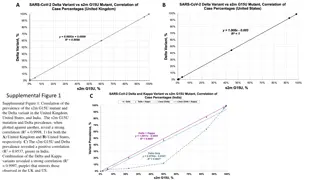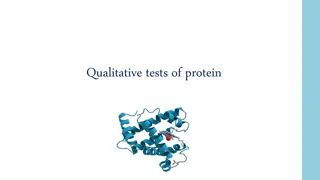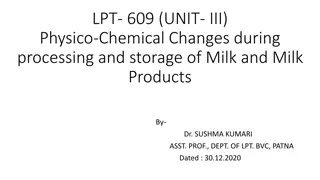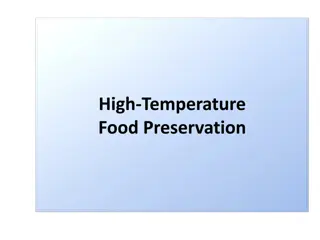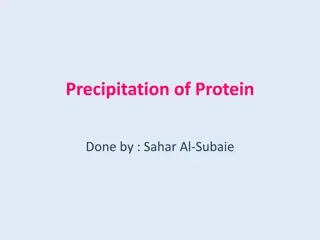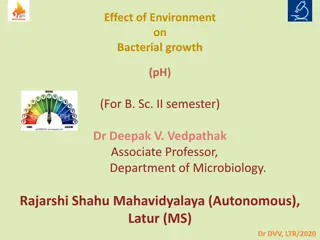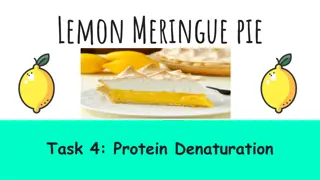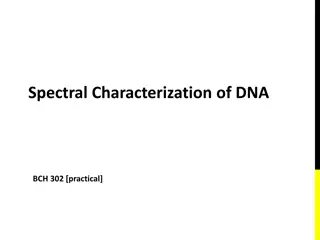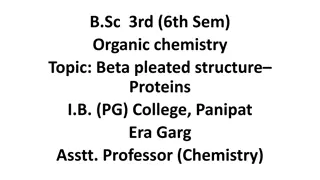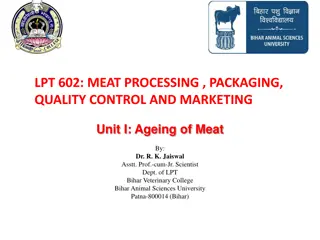Comprehensive DNA Characterization Methods in Molecular Biology
Explore the various techniques involved in the characterization of DNA, including spectrophotometric assay, melting temperature determination, quantitative and qualitative analyses, DNA purity assessment, GC content calculation, and DNA denaturation processes. Learn how to determine DNA concentratio
0 views • 12 slides
Correlation of s2m G15U Mutant and Delta Variant Prevalence
The correlation between the prevalence of the s2m G15U mutant and the Delta variant in the UK, US, and India was analyzed, showing strong correlations in the UK and US, and a positive correlation in India. Analysis of the s2m phenotype in the Alpha, Delta, and Kappa variants was also conducted. Addi
3 views • 4 slides
Protein Qualitative Tests and Precipitation Methods
Qualitative tests of proteins involve reactions producing colored products, such as the Biuret test specifically detecting peptide bonds. Protein precipitation methods are used for concentration and purification, affected by factors like pH, temperature, salts, and heavy metals. Different techniques
1 views • 17 slides
Physico-Chemical Changes in Milk and Milk Products During Processing and Storage
Physico-chemical changes occur in milk and milk products during processing and storage, including alterations such as salt precipitation, protein denaturation, and flavor changes. Heat treatments like autoclaving and freezing impact the composition, properties, and flavor of milk. Understanding thes
0 views • 9 slides
The Intriguing Structure and Functions of DNA
DNA, or Deoxyribonucleic Acid, is a fundamental molecule in living organisms, characterized by its double helical structure consisting of two antiparallel polynucleotide chains. Each strand is composed of nucleotide monomers, comprising deoxyribose sugar, phosphate group, and nitrogenous bases (puri
0 views • 12 slides
Understanding Enzyme Activity and Optimal Conditions
This interactive content provides a detailed exploration of enzyme activity through data interpretation and graph analysis. Questions range from identifying the impact of enzymes on specific molecules to determining optimal conditions for various enzyme functions such as pH and temperature. Users de
0 views • 16 slides
Understanding the Effects of High Temperatures on Microorganisms in Food Preservation
High temperatures are utilized to preserve food by affecting microorganisms. Heating can lead to various outcomes such as heat shock, sublethal injury, or cell death in microbial cells and spores. The mechanisms of damage include loss of permeability, denaturation of key components, and inability to
0 views • 18 slides
Protein Denaturation and Precipitation: Mechanisms and Effects
Protein denaturation is a process where proteins lose their native structure due to external factors like heat, strong acids, or bases. This leads to protein aggregation and precipitation. Different types of denaturation exist, including reversible and irreversible forms. Strong mineral acids can al
1 views • 21 slides
pH Effects on Bacterial Growth: The Influence of Environment
This study explores the impact of pH levels on bacterial growth, highlighting the minimum, optimum, and maximum pH requirements for different categories of microbes - acidophiles, neutrophiles, and alkaliphiles. It delves into the consequences of pH variations on cellular processes like DNA stabilit
0 views • 8 slides
Exploring Protein Denaturation in Lemon Meringue Pie Recipe
Explore the process of protein denaturation in the context of making a delicious Lemon Meringue Pie. Learn about the steps involved in creating the pastry, lemon curd, and meringue topping. Discover the science behind protein denaturation and its role in culinary preparations. Unveil the sensory eva
0 views • 10 slides
Understanding Polymerase Chain Reaction (PCR) in Genetic Engineering
Polymerase Chain Reaction (PCR) is a key enzymatic method in genetic engineering developed in 1983. It amplifies targeted regions of DNA, aiding in various applications like studying diseases, forensic analysis, and analyzing ancient DNA. PCR involves heating, denaturation, primer binding, and exten
0 views • 14 slides
Understanding DNA Structure and Denaturation Process
DNA is a double helical structure made of 2 antiparallel polynucleotide chains with nucleotide monomers. The structure contains deoxyribose sugar, phosphate groups, and nitrogenous bases (purines and pyrimidines). Hydrogen bonds between base pairs stabilize the structure. Denaturation can occur due
0 views • 16 slides
Understanding Beta Pleated Sheet Structure in Proteins
Beta pleated sheet structure is a secondary structure found in proteins where peptide chains lie side by side to form a flat sheet held together by hydrogen bonds. Proteins like keratin and fibroin exhibit this structure, while denaturation can alter the secondary and tertiary structures of proteins
0 views • 9 slides
Understanding the Ageing Process of Meat in Meat Processing
Ageing of meat is a crucial process in meat processing that involves holding unprocessed meat at specific temperatures to enhance tenderness and flavor. This process, also known as ripening or conditioning, triggers physical and chemical changes in protein structure, collagen, and proteolysis. Diffe
0 views • 11 slides
Exploring Exponential Growth in Polymerase Chain Reaction (PCR) for Novel Product Production
Delve into the fascinating world of Polymerase Chain Reaction (PCR) to understand exponential growth in product production using molecular biology and mathematical concepts. High school biology standards, algebraic models, and learning goals are intertwined to predict product amounts and assess modi
0 views • 14 slides

